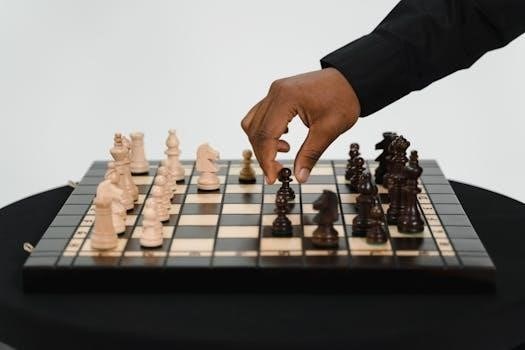Chess openings form the initial phase of a game, with established theory guiding early moves. Many sequences have standard names, such as the Sicilian Defense. Understanding these is crucial for success.
The Importance of Opening Theory
The first few moves in chess are crucial, laying the groundwork for the entire game. Familiarity with popular openings and their underlying theory is essential for success. Opening theory provides a framework for controlling the center, developing pieces effectively, and preparing for the middlegame. A solid grasp of opening principles can give you an early advantage, while a poor opening can easily lead to a disadvantage. Consistent study and application of opening theory can significantly improve your overall chess gameplay and results. Understanding basic opening moves helps to avoid common traps.
Understanding ECO Codes
The Encyclopedia of Chess Openings (ECO) codes categorize chess openings into five broad areas, A through E, each with 100 subcategories. These codes help to organize and study openings.
Classification of Chess Openings
Chess openings are broadly classified using the ECO system, ranging from A00 to E99. This system organizes openings into categories based on initial moves and pawn structures. Volume C, for instance, covers the French Defense and Open Games, while Volume B includes other King’s Pawn openings. Volume D focuses on Closed Games. Understanding this classification is crucial for systematically studying chess openings. The ECO system provides a structured framework for exploring the vast landscape of chess opening theory, aiding players in navigating the complex world of opening moves and variations. This system helps in targeted study.

Popular Chess Openings
Many chess openings are popular, with some considered the greatest. Examples include the Queen’s Pawn Opening and the Accelerated London System; These are widely studied and used by players.
Top 10 Chess Openings
While there isn’t a single, universally agreed-upon list, some openings are consistently favored by players. The Queen’s Pawn Opening, particularly the Accelerated London System, frequently appears in discussions as a top choice. Many lists also include the Sicilian Defense, known for its complex and dynamic play. Other popular contenders often include openings like the French Defense, Italian Game, and Ruy Lopez. These are all based on solid positional play and tactical possibilities. It’s crucial to pick openings that fit your style.
Key Openings for Beginners
For beginners, focusing on simple openings is best. The Italian Game and the Ruy Lopez are great starting points. These teach key opening principles.
Essential Openings to Learn
Beginners should prioritize learning fundamental openings like the Italian Game, which develops pieces quickly. The Sicilian Defense, while more complex, is another popular and useful opening to understand. It’s crucial to grasp the basic principles, such as controlling the center and developing your pieces efficiently. Focusing on a few key openings allows beginners to build a solid foundation for their chess strategy. Avoiding overly complex openings at the start will help to avoid confusion and focus on the main concepts of chess.

Chess Opening Resources
Online databases and explorers offer vast information on chess openings. These tools allow players to study moves, variations, and master games to improve their opening play.
Online Databases and Explorers
Numerous online resources provide extensive databases of chess openings, allowing users to explore move-by-move variations. These databases often include statistics on the popularity and success rates of different lines, aiding players in making informed decisions. Interactive explorers enable users to visualize opening trees, study master games, and delve deep into specific variations. These tools are invaluable for players seeking to expand their knowledge and improve their opening repertoire. Furthermore, many platforms offer features like analysis engines and user annotations, enhancing the study experience. Such resources have made the study of chess openings more accessible and comprehensive than ever.
Named Chess Openings
Many chess openings have established names, like the Sicilian Defense. The Oxford Companion to Chess lists 1,327 named openings and variants, with many more existing.
Extensive List of Openings
The world of chess openings is vast, with resources like the Jimmyvermeer.com website listing over 3700 named variations, ranging from A00 to E99. Even with such extensive lists, some lines and deviations might remain unlisted. Wikipedia and other chess resources provide further details on numerous openings. The Encyclopaedia of Chess Openings (ECO) categorizes these into five broad areas, each with 100 subcategories, highlighting the depth and breadth of chess opening theory. This vastness requires dedicated study.
Chess Opening Repertoires
Building a solid opening repertoire is vital for chess players. It involves selecting openings that suit your style. This creates a strong foundation for the middlegame.
Building a Solid Opening Game
Developing a strong opening game involves more than just memorizing moves. It’s about understanding the underlying principles and strategic ideas behind each opening. A good opening repertoire should include openings that you are comfortable with and that align with your playing style. This provides a solid foundation for the middlegame, allowing you to build upon a well-constructed position. Focus on understanding the typical pawn structures and plans that arise from your chosen openings. This approach will lead to more consistent results and a deeper understanding of the game.

Learning Chess Openings
Interactive guides and videos offer an engaging way to learn chess openings. These resources help players grasp opening lines for the Italian, Sicilian, French, and other popular choices.
Interactive Guides and Videos
Many online platforms now offer interactive guides and videos that are specifically designed to help chess players learn openings. These resources often break down complex opening lines into easy-to-understand segments, making the learning process more engaging and accessible. Videos can visually demonstrate the moves, while interactive guides allow users to practice and reinforce their understanding. This approach is particularly useful for beginners who may find traditional chess literature overwhelming. These resources cover a wide array of openings, from basic to complex, catering to all skill levels.
Chess Opening Variations
Exploring different lines within chess openings is essential for advanced play. Variations offer diverse strategic options, making each game unique and requiring deep understanding of the nuances;
Exploring Different Lines
Chess openings are not rigid paths; they branch into countless variations, each with its own strategic implications. These different lines can lead to diverse middlegame positions, requiring adaptability and a deep understanding of the underlying principles. Learning to navigate these variations is crucial for improving chess skills, allowing players to respond effectively to different opponent strategies. Mastering these varied paths enables a player to avoid predictable patterns and introduce unexpected complexities into the game. Exploring these paths enhances the understanding of positional nuances.

Advanced Opening Study
Mastering complex variations requires in-depth analysis and study. Advanced players delve into intricate lines, understanding the subtle nuances and strategic implications that arise from different move orders.
Mastering Complex Variations
Delving into the intricacies of chess openings demands a profound understanding of complex variations. This involves not only memorizing move sequences but also grasping the underlying strategic ideas. Players must analyze the consequences of each move, anticipating their opponent’s responses. Mastering these variations requires a combination of theoretical knowledge, analytical skills, and practical experience. It’s about understanding the “why” behind the moves, not just the “what.” This advanced study allows players to navigate intricate positions with confidence and precision, leading to a deeper level of chess mastery and improved outcomes.
